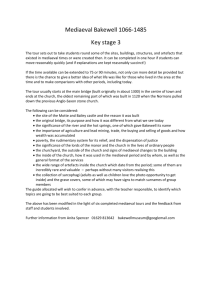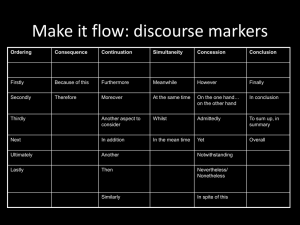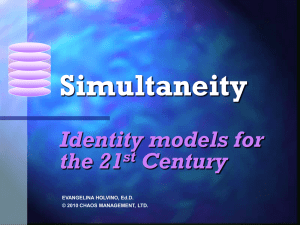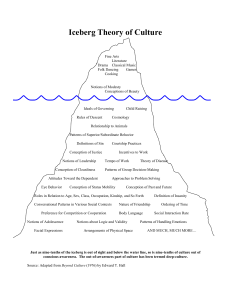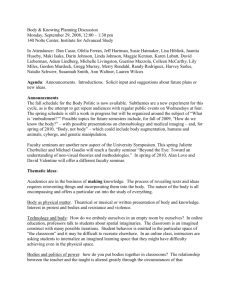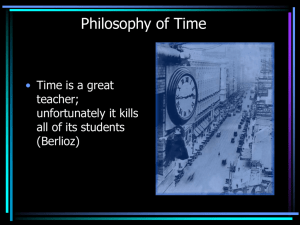IMAGINED COMMUNITIES
advertisement
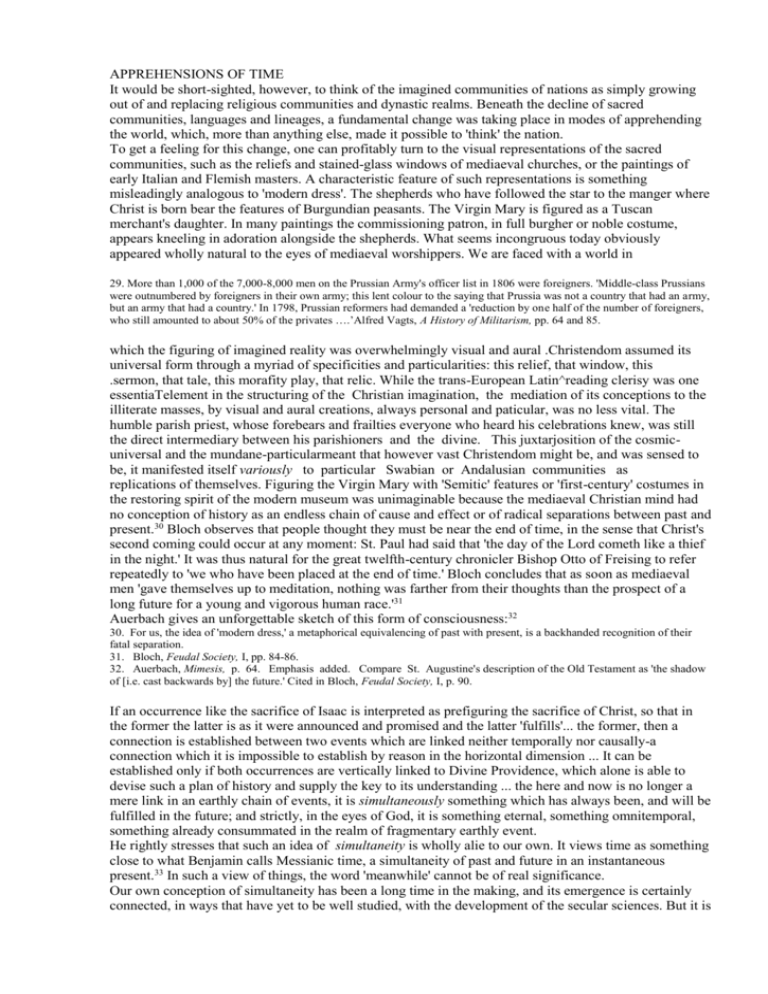
APPREHENSIONS OF TIME It would be short-sighted, however, to think of the imagined communities of nations as simply growing out of and replacing religious communities and dynastic realms. Beneath the decline of sacred communities, languages and lineages, a fundamental change was taking place in modes of apprehending the world, which, more than anything else, made it possible to 'think' the nation. To get a feeling for this change, one can profitably turn to the visual representations of the sacred communities, such as the reliefs and stained-glass windows of mediaeval churches, or the paintings of early Italian and Flemish masters. A characteristic feature of such representations is something misleadingly analogous to 'modern dress'. The shepherds who have followed the star to the manger where Christ is born bear the features of Burgundian peasants. The Virgin Mary is figured as a Tuscan merchant's daughter. In many paintings the commissioning patron, in full burgher or noble costume, appears kneeling in adoration alongside the shepherds. What seems incongruous today obviously appeared wholly natural to the eyes of mediaeval worshippers. We are faced with a world in 29. More than 1,000 of the 7,000-8,000 men on the Prussian Army's officer list in 1806 were foreigners. 'Middle-class Prussians were outnumbered by foreigners in their own army; this lent colour to the saying that Prussia was not a country that had an army, but an army that had a country.' In 1798, Prussian reformers had demanded a 'reduction by one half of the number of foreigners, who still amounted to about 50% of the privates ….’Alfred Vagts, A History of Militarism, pp. 64 and 85. which the figuring of imagined reality was overwhelmingly visual and aural .Christendom assumed its universal form through a myriad of specificities and particularities: this relief, that window, this .sermon, that tale, this morafity play, that relic. While the trans-European Latin^reading clerisy was one essentiaTelement in the structuring of the Christian imagination, the mediation of its conceptions to the illiterate masses, by visual and aural creations, always personal and paticular, was no less vital. The humble parish priest, whose forebears and frailties everyone who heard his celebrations knew, was still the direct intermediary between his parishioners and the divine. This juxtarjosition of the cosmicuniversal and the mundane-particularmeant that however vast Christendom might be, and was sensed to be, it manifested itself variously to particular Swabian or Andalusian communities as replications of themselves. Figuring the Virgin Mary with 'Semitic' features or 'first-century' costumes in the restoring spirit of the modern museum was unimaginable because the mediaeval Christian mind had no conception of history as an endless chain of cause and effect or of radical separations between past and present.30 Bloch observes that people thought they must be near the end of time, in the sense that Christ's second coming could occur at any moment: St. Paul had said that 'the day of the Lord cometh like a thief in the night.' It was thus natural for the great twelfth-century chronicler Bishop Otto of Freising to refer repeatedly to 'we who have been placed at the end of time.' Bloch concludes that as soon as mediaeval men 'gave themselves up to meditation, nothing was farther from their thoughts than the prospect of a long future for a young and vigorous human race.'31 Auerbach gives an unforgettable sketch of this form of consciousness:32 30. For us, the idea of 'modern dress,' a metaphorical equivalencing of past with present, is a backhanded recognition of their fatal separation. 31. Bloch, Feudal Society, I, pp. 84-86. 32. Auerbach, Mimesis, p. 64. Emphasis added. Compare St. Augustine's description of the Old Testament as 'the shadow of [i.e. cast backwards by] the future.' Cited in Bloch, Feudal Society, I, p. 90. If an occurrence like the sacrifice of Isaac is interpreted as prefiguring the sacrifice of Christ, so that in the former the latter is as it were announced and promised and the latter 'fulfills'... the former, then a connection is established between two events which are linked neither temporally nor causally-a connection which it is impossible to establish by reason in the horizontal dimension ... It can be established only if both occurrences are vertically linked to Divine Providence, which alone is able to devise such a plan of history and supply the key to its understanding ... the here and now is no longer a mere link in an earthly chain of events, it is simultaneously something which has always been, and will be fulfilled in the future; and strictly, in the eyes of God, it is something eternal, something omnitemporal, something already consummated in the realm of fragmentary earthly event. He rightly stresses that such an idea of simultaneity is wholly alie to our own. It views time as something close to what Benjamin calls Messianic time, a simultaneity of past and future in an instantaneous present.33 In such a view of things, the word 'meanwhile' cannot be of real significance. Our own conception of simultaneity has been a long time in the making, and its emergence is certainly connected, in ways that have yet to be well studied, with the development of the secular sciences. But it is a conception of such fundamental importance that, without taking it fully into account, we will find it difficult to probe the obscure genesis of nationalism. What has come to take the place of the mediaeval conception of simultaneity-along-time is, to borrow again from Benjamin, an idea of 'homogeneous, empty time, in which simultaneity is, as it were, transverse, cross-time, marked not by prefiguring and fulfilment, but by temporal coincidence, and measured by clock and calendar.34 Why this transformation should be so important for the birth of the imagined community of the nation can best be seen if we consider the basic structure of two forms of imagining which first flowered in 33. Walter Benjamin, Illuminations, p. 265. 34. Ibid., p. 263. So deep-lying is this new idea that one could argue that every essential modern conception is based on a conception of 'meanwhile'. Europe in the eighteenth century: the novel and the newspaper.35 For these forms provided the technical means for 're-presenting' the kind of imagined community that is the nation. Consider first the structure of the old-fashioned novel, a structure typical not only of the masterpieces of Balzac but also of any contemporary dollar-dreadful. It is clearly a device for the presentation of simultaneity in 'homogeneous, empty time,' or a complex gloss upon the word 'meanwhile'. Take, for illustrative purposes, a segment of a simple novel-plot, in which a man (A) has a wife (B) and a mistress (C), who in turn has a lover (D). We might imagine a sort of time-chart for this segment as follows: Time: II III Events: A quarrels with В A telephones С dines at home with В D plays pool С has an ominous dream D gets drunk in a bar С and D make love В shops A Notice that during this sequence A and D never meet, indeed may not even be aware of each other's existence if С has played her cards right.36 What then actually links A to D? Two complementary conceptions: First, that they are embedded in 'societies' (Wessex, Lubeck, Los Angeles). These societies are sociological entities of such firm and stable reality that their members (A and D) can even be described as passing each other on the street, without ever becoming acquainted, and still be connected.37 Second, that A and D are 35. While the Princesse de Cleves had already appeared in 1678, the era of Richardson, Defoe and Fielding is the early eighteenth century. The origins of the modern newspaper lie in the Dutch gazettes of the late seventeenth century; but the newspaper only became a general category of printed matter after 1700. Febvre and Martin, The Coming of the Book, p. 197. 36. Indeed, the plot's grip may depend at Times I, II, and III on А, В, С and D not knowing what the others are up to. 37. This polyphony decisively marks off the modern novel even from so brilliant a forerunner as Petronius's Satyricon. Its narrative proceeds single file. If Encolpius bewails his young lover's faithlessness, we are not simultaneously shown Gito inbea with Ascyltus. embedded in the minds of the omniscient readers. Only they, like God, watch A telephoning С, В shopping, and D playing pool all at once. That all these acts are performed at the same clocked, calendrical time, but by actors who may be largely unaware of one another, shows the novelty of this imagined world conjured up by the author in his readers' minds.38 The idea of a sociological organism moving calendrically through homogeneous, empty time is a precise analogue of the idea of the nation, which also is conceived as a solid community moving steadily down (or up) history.39 An American will never meet, or even know the names of more than a handful of his 240,000-odd fellow-Americans. He has no idea of what they are up to at any one time. But he has complete confidence in their steady, anonymous, simultaneous activity. 38. In this context it is rewarding to compare any historical novel with documents or narratives from the period fictionalized. 39. Nothing better shows the immersion of the novel in homogeneous, empty time than the absence of those prefatory genealogies, often ascending to the origin of man, which are so characteristic a feature of ancient chronicles, legends, and holy books.
